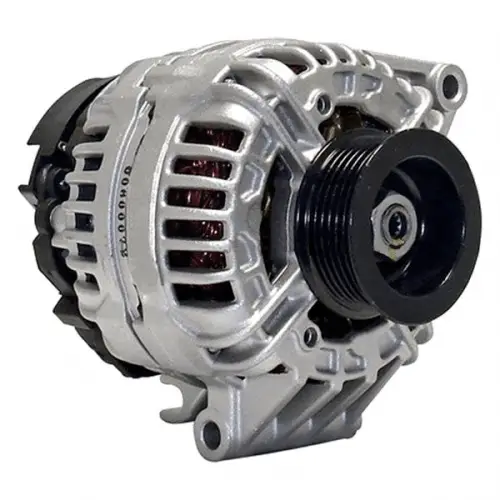An alternator and a generator are both devices that work using the same principle.
However, there are major factors that set the two apart.
Summary Table
| Alternator | Generator |
| Converts mechanical energy into alternating current (AC) | Converts mechanical energy into alternating current (AC) or direct current (DC) |
| Mainly used for supplying power to different types of automobiles such as cars, yachts, and trains | Mainly used as an alternative source of energy to power homes and large industries |
| Can be used to charge dead batteries | Can be used to charge batteries and excite an alternator |
| Mainly made up of a stator, a rotor, a voltage regulator, and a diode | Mainly made up of an engine, an alternator, a voltage regulator, a control panel, a fuel system, an exhaust system, a lubricating system, a frame, and a battery charger |
| Generates electric power by using mechanical energy and motion to create an alternating magnetic field | Facilitates conversion by forcing electric charges (found in wirings) to move into an external electric circuit, which consequently leads to electric power generation |
Definitions

An alternator is a device mainly used to convert mechanical into alternating current (AC).

A generator is an electric device that facilitates the conversion of mechanical into either alternating current (AC) or direct current (DC).
Alternator vs Generator
At first glance, both of these pieces of electrical equipment seem to function similarly, but there is a big difference between an alternator and a generator. Read more to learn how to distinguish between the two.
Conversion
An alternator was specifically engineered to convert mechanical energy into alternating current (AC), which is a type of electrical current that moves in reverse directions at regular intervals. A generator, by contrast, is capable of converting mechanical energy into electrical power in the forms of alternating current (AC) and direct current (DC).
Unlike AC, DC is a type of energy that consistently flows in one direction.
Main Applications
The two are very much alike in terms of power generation, but they have different capabilities and applications. For one, since generators cannot supply enough power to keep car accessories operational, alternators are the more ideal choice for power production in different types of automobiles such as cars, yachts, and trains. Playing a critical role in the car’s charging system, an alternator can also resupply energy to dead batteries.
A generator, on the other hand, is commonly used as an alternative source of energy that powers homes and even large industries. Additionally, since a generator can produce constant output voltage, it can be used to either charge batteries or excite alternators.
Energy Generation
Both produce electric energy from mechanical energy, but they do so in different ways. An alternator is made up of four major components: 1) a stator, 2) a rotor, 3) a voltage regulator, and 4) a diode. Energy conversion starts as the engine sends the alternator pulley into a rotating motion, causing the rotor to spin rapidly. The rotor then creates an alternating magnetic field that sends AC into the stator. The AC from the stator continues to flow into the diodes, which give direction to the current. As current passes through, the voltage regulator limits the voltage supplied to the car battery to prevent overcharging.
Comparatively, a generator is a more complex device mainly made up of 9 parts: 1) an engine, 2) an alternator, 3) a voltage regulator, 4) a control panel, 5) a fuel system, 6) an exhaust system, 7) a lubricating system, 8) a frame, and 9) a battery charger. Just like an alternator, a generator works under Michael Faraday’s principle of electromagnetic induction, which explains the relationship between motion, magnetic field, and electric current. Once powered by coal or other forms of energy, a generator facilitates conversion by forcing electric charges (found in wirings) to move into an external electric circuit, thereby causing electric power generation.





